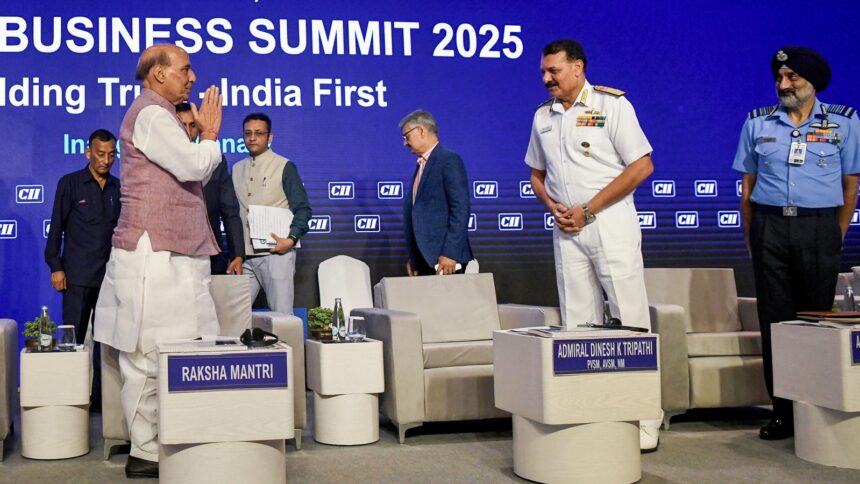Defence Minister Rajnath Singh said Thursday that India could have done “a lot more” beyond destroying terrorist hideouts and Pakistani military bases in , but presented a great example of “coordination of power and restraint”.
He said the use of indigenous systems during Operation Sindoor proves that India has the power to penetrate any armour of the enemy.
Addressing the inaugural plenary of the Confederation of Indian Industry (CII) Annual Business Summit, Singh also said that Pakistan-occupied Kashmir is a part of India and people who got separated geographically and politically will, sooner or later, voluntarily return to India. “Even after separation, the confidence and faith of the elder brother towards his younger brother remains intact.”
“The government led by Prime Minister is committed to its resolve of Ek Bharat Shreshtha Bharat. Most of the people in PoK have a deep connection with India. There are only a few who have been misled,” he said.
India, he said, has redesigned and redefined its strategy and response against terrorism, and Pakistan has realised that running the business of terrorism is not cost-effective, rather it may have to pay a heavy price.
He said India has recalibrated its engagement and scope of dialogue with Pakistan, and now talks will only be held on terrorism and PoK.
Singh said the Indian Armed Forces would not have been able to take effective action against terrorism in Pakistan and PoK if the nation had not strengthened its indigenous defence capabilities.
He also called the Advanced Medium Combat Aircraft (AMCA) programme execution model a bold and decisive step through which the private sector will get an opportunity to participate in a mega defence project along with public sector companies for the first time, further bolstering indigenous defence capabilities.
“Under the AMCA project, the plan is to develop five prototypes, which will be followed by series production. It is a key milepost in the history of the Make-in-India programme,” he said.
Singh asked the Indian industry to focus on national interest, more than company interest. “If securing company interest is your karma, safeguarding national interest is your dharma,” he said.
“Today, India is not just a consumer of defence technology, but has also become a producer and exporter. When the world approaches us for high-end defence systems, it is not just a market indication, it is a respect for our capability,” he said.
He said 10-11 years ago, India’s defence production was approximately Rs 43,000 crore, adding that today, it has crossed Rs 1,46,000 crore, with a contribution of over Rs 32,000 crore by the private sector.
“Our defence exports, which were around Rs 600-700 crore 10 years ago, have surpassed a record figure of Rs 24,000 crore today. Our weapons, systems, sub-systems, components and services are reaching around 100 countries. Over 16,000 MSMEs, associated with the defence sector, have become the backbone of the supply chain,” he said.
“These companies are not only strengthening our self-reliance journey, but are also providing employment to lakhs of people,” he said.
He said India is not only producing fighter aircraft and missile systems, it is also getting ready for New Age warfare technology.
“We are continuously making headway even in frontier technologies. Our progress in the field of artificial intelligence, cyber defence, unmanned systems and space-based security is being recognised on the global stage. India has the potential to become a development hub for engineering, high precision manufacturing and future technologies,” he said.
In a separate address, Navy chief Admiral Dinesh K Tripathi said the lines between war and peace are increasingly getting blurred and commercial technologies are now available to non-state actors. He said this is an era for mass precision, where highly accurate capabilities in large numbers remain important.
He said non-traditional threats such as acts of terror can quickly spiral into conflict, and the use of non-contact warfare along with space and cyber domains to wage a conflict with no ceasefire is a reality.
“In this new paradigm, the industry has to see itself at the frontlines of national defence,” he said, adding that the Navy is committed to becoming a fully Atmanirbhar force by 2047.
Defence Secretary R K Singh said Operation Sindoor trampled upon the red lines set earlier. “We made it clear to Pakistan that the era of sponsored cross-border terrorism, under the shadow of nuclear blackmail and blasts, is over. Terror havens and factories will be struck at their sources and actions will not be limited only to foot soldiers,” he said.








